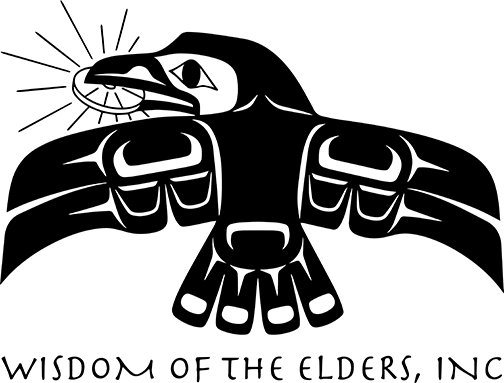Anne White Hat and Marie Randall
Arlie Neskahi:
Corn mother, corn maiden, sister corn – she is called many things, but the stories of her gift of life are told and retold even today throughout many Native nations. Native Americans were the first to cultivate corn, well before the arrival of Columbus. It has since spread around the world, sustaining people in countries far from Turtle Island. Judy Bluehorse Skelton offers insights into the significance of this sacred plant.
Judy Bluehorse Skelton:
Near the beginning of time, brother crow brought seeds of all sorts, especially corn, to nourish and replenish the people. And the people cultivated their gardens so that when game was scarce they did not go hungry. Sister corn gives of herself so that they might live, and the people return thanks to her in songs and ceremonies at planting time and at harvest.
Corn woman is the bringer of life, her silken hair dancing in the wind. Corn mother is revered for sustaining not only the body but also the spirit of the people. In many Native traditions, there are four sacred plants – corn, squash, beans, and tobacco. Corn was most prominent to the people’s physical survival, and corn and tobacco together were at the heart of their spiritual survival. Tobacco is a pleasing offering that carries the prayers of the people to the spirits, joining the breath of the people with the wind, which is the breath of creation. Corn is both a physical and spiritual essence, a gift of the spirits and a spirit itself.

American Crow. Courtesy of the National Parks Service. www.nps.gov
Music:
New Awakening
Burning Sky
Burning Sky: Music for Native American Flute/Guitar/Percussion
Canyon Records
www.canyonrecords.com
Native women had cultivated over 2,000 varieties of corn by the time Columbus arrived. The great diversity of corn plants reflected the very different climates they could be grown in; from the high, dry deserts of the southwest to the cooler river bottomlands of the northern plains. This diversity respected the natural ways of the land, taking into account the animals, the insects, the soil, water availability and the weather patterns of each region.

George Catlin American, 1796 - 1872 Green Corn Dance - Minatarrees, 1861 oil on card mounted on paperboard, 45.2 x 60 cm (17 13/16 x 23 5/8 in.) Paul Mellon Collection 1965 Courtesy of the National Gallery of Art www.nga.gov
Planting was done by forming small hills instead of rows, and using digging sticks instead of plows. Hoed only once or twice during the growing season, the corn would be harvested, and the best seeds collected for next year’s planting. In the eastern woodlands, seeds of the “three sisters,” corn, beans and squash, were planted together. The bean vines climb up the cornstalks for support, while the big leaves of the squash spread along the ground, keeping the corn’s roots shady and cool. The three sisters worked harmoniously to nourish and protect each other through the long, hot days of summer. Nearly every tribe who grew corn held green corn celebrations when the corn was ready for picking.
Music:
New Awakening
Burning Sky
Burning Sky: Music for Native American Flute/Guitar/Percussion
Canyon Records
www.canyonrecords.com
Corn woman’s versatility is unmatched: she can be eaten raw, when fresh and green; or dried and ground into cornmeal for cakes, bread and soup. She can be parched, steamed, soaked, roasted and popped. The corn silk, pollen, cornstalks and cornhusks all offer additional gifts of medicine, craft and ceremony.
Lewis and Clark came upon one of the greatest trading centers when they visited the region of the Arikara, Mandan and Hidatsa peoples. In late autumn of 1804, they found themselves at a hub of Indian trade. Lewis and Clark observed Native people who had come hundreds of miles to exchange trade goods for the corn, beans, dried squash, and sunflower seeds grown by these gardening tribes. Lewis and Clark were surprised to find that even amongst warring tribes, a truce would be called to allow for this traditional trading time. When Lewis and Clark asked these vegetable growing tribes why they would trade with their enemy, they explained that it was the way their fathers and grandfathers, going back many generations, had chosen to maintain a balance.

Corn varieties of the Upper Missouri collected on the Fort Berthold reservation for Thomas Jefferson at the turn of the century. Left to right: Mandan soft red flour, Mandan blue, Arikara mixed flint, Mandan yellow flint. The Ethnography of Lewis and Clark: Native American objects and the American Quest for Commerce and Science. Courtesy of the Peabody Museum of Archaeology and Ethnology, Harvard University. www.peabody.harvard.edu/ Lewis_and_Clark/images
Music:
New Awakening
Burning Sky
Burning Sky: Music for Native American Flute/Guitar/Percussion
Canyon Records
www.canyonrecords.com
Corn mother’s gifts have spread around the world to nourish and sustain us all. Today, large agricultural businesses grow less than five varieties of corn commercially, and they are planted in rows that stretch for miles, alone, without their sisters, beans and squash to keep them company.
Native people, still planting heirloom seeds that have been passed down for generations, continue to honor corn mother’s gifts with songs and dances and green corn celebrations.
With each breath, with each step, with each heart beat. Osadadu.
Neskahi:
Educator, writer and herbalist Judy Bluehorse Skelton is Nez Perce, Chickasaw and Cherokee. She lives and works in Portland, Oregon.

